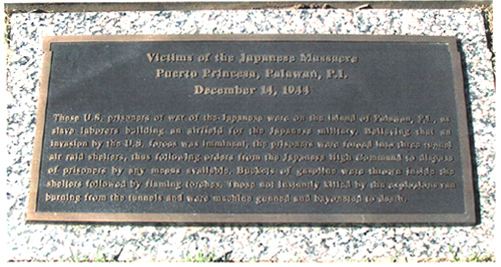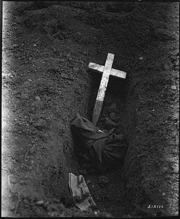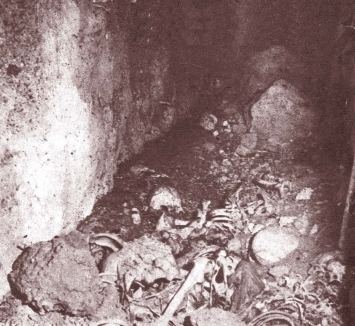Date 14 December 1944 | ||
 | ||
Location | ||
The p o w palawan massacre memorial puerto princesa
The Palawan massacre occurred on 14 December 1944, during World War II, near the city of Puerto Princesa in the Philippine province of Palawan. Allied soldiers, imprisoned near the city, were murdered by Japanese soldiers during an air raid.
Contents
- The p o w palawan massacre memorial puerto princesa
- Palawan massacre of good people m4v
- Prisoners of War at Puerto Princesa
- Appearance in literature
- References

Palawan massacre of good people m4v
Prisoners of War at Puerto Princesa

In order to prevent the rescue of prisoners of war by the advancing Allies, on 14 December 1944, units of the Japanese Fourteenth Area Army (under the command of General Tomoyuki Yamashita) brought the POWs back to their own camp. During an air raid warning, the 150 prisoners of war at Puerto Princesa hid in three covered trenches for refuge; the Japanese soldiers set the trenches on fire using barrels of gasoline.

Prisoners who tried to escape the flames were shot down by machine gun fire. Others attempted to escape by climbing over a cliff that ran along one side of the trenches, but were later hunted down and killed. Only 11 men escaped the slaughter; 139 were killed. Of the victims, 123 are buried in a mass grave at Jefferson Barracks National Cemetery, St Louis Missouri.
The incident sparked a series of POW rescue campaigns by the US, such as the raid at Cabanatuan on January 30, 1945, the raid at Santo Tomas Internment Camp on February 3, 1945, the raid of Bilibid Prison on February 4, 1945, and raid at Los Baños on February 23, 1945. It was testimony of survivor Pfc. Eugene Nielsen that convinced the US military to embark on a campaign to save the POWs in Philippines in 1945. In 2006, Nielsen was interviewed again by Geoffrey Panos on the behalf of the University of Utah.

Bones from the victims were discovered in early 1945. 16 Japanese soldiers were tried for the massacre, at Yokohama in August 1948. The Japanese personnel involved in the massacre were initially sentenced to death, but later, they were released in the general amnesty.
Appearance in literature
The massacre is the basis for the book Last Man Out: Glenn McDole, USMC, Survivor of the Palawan Massacre in World War II by Bob Wilbanks, and the opening scenes of the 2005 Miramax film, The Great Raid. A memorial has been erected on the site and McDole, in his eighties, was able to attend the dedication.
Evidence of the episode has been recorded by two of the eleven survivors: Glenn McDole and Rufus Willie Smith from the 4th US Marines.
